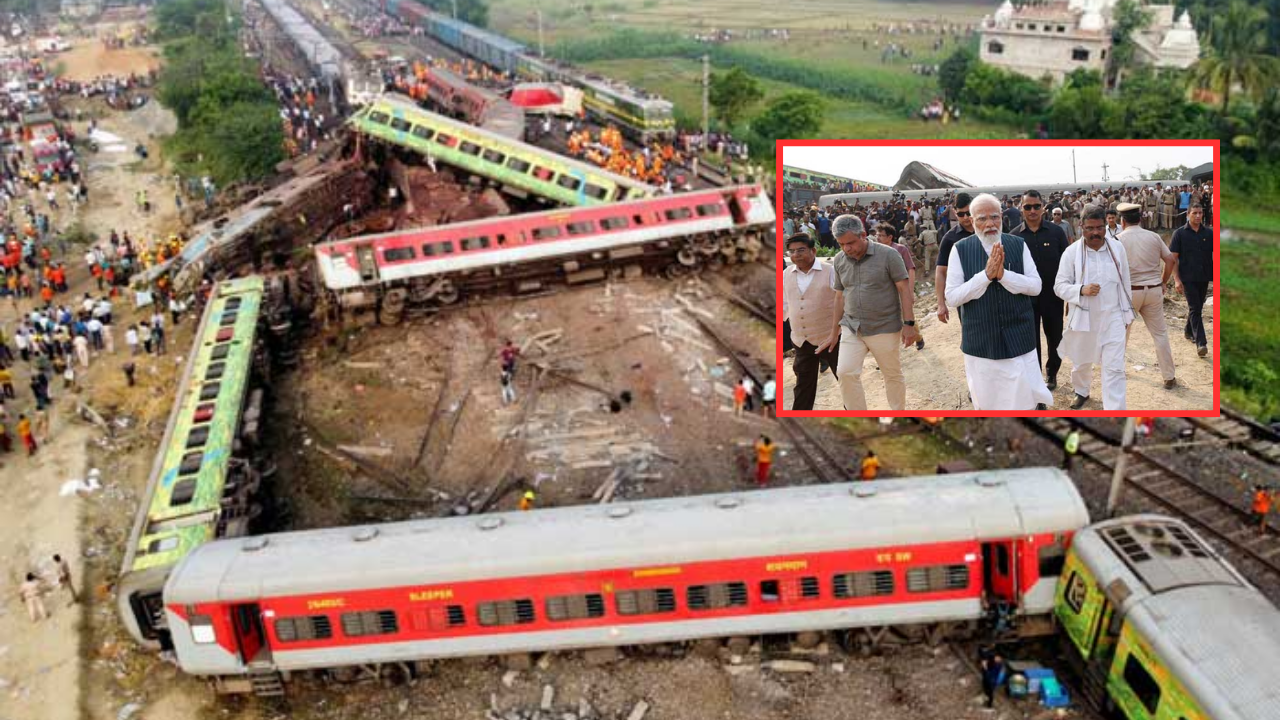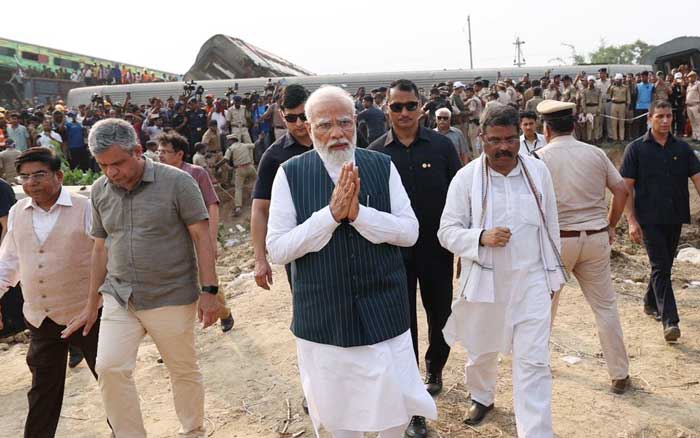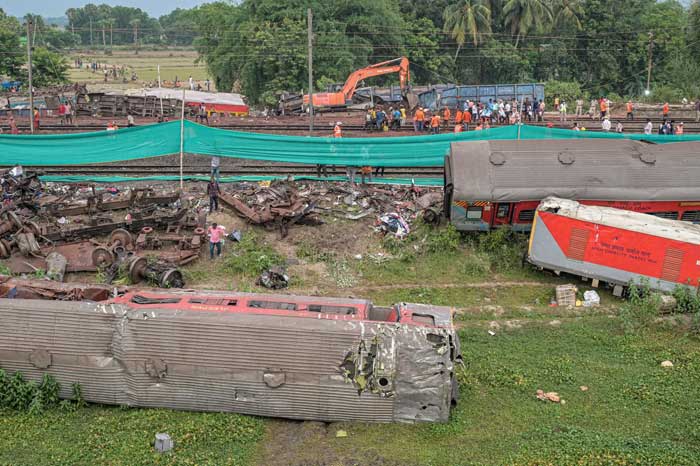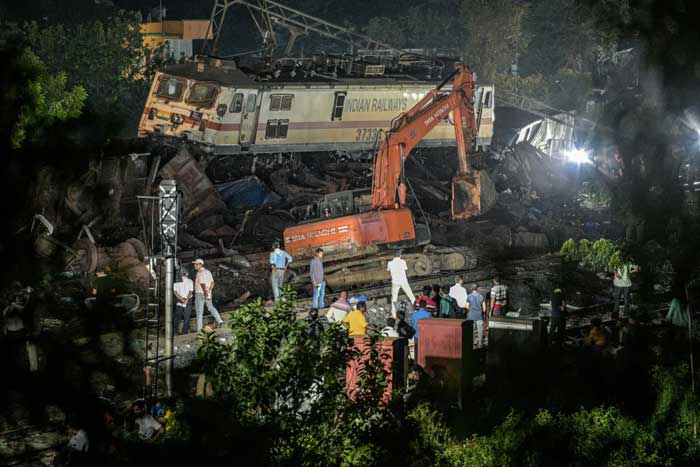
An initial investigation into a train crash that killed nearly 300 people in the Indian state of Odisha has blamed a signal fault for the disaster. But there is a long story behind the train system in this South Asian country.
Electronic signal error
Indian Railways Minister Ashwini Vaishnaw said on June 5 that the country’s worst train accident in more than two decades was caused by an electronic signal fault that caused the train to go on the wrong track.
A full investigation into the June 2 train disaster near Balasore in Odisha state, which killed at least 275 people and injured more than 1,000, is still underway but “the root cause has been determined,” Ashwini Vaishnaw said.
 Indian Prime Minister Narendra Modi visited the scene to assess the disaster and console the families of the victims. Photo: Sky News
Indian Prime Minister Narendra Modi visited the scene to assess the disaster and console the families of the victims. Photo: Sky News
According to initial investigation, the green light was given to the Shalimar-Chennai Coromandel Express to keep it on the main track. However, the signal was later changed and directed the train carrying 1,257 passengers onto an adjacent loop track, causing it to collide with a freight train loaded with iron ore that was parked there.
As a result, the locomotive and four to five coaches of the Shalimar-Chennai Coromandel Express overturned onto another track and collided with the Yesvantpur-Howrah Express passenger train coming from the opposite direction. The collision also derailed the third train and threw it off the track.
Speaking to the Times of India, Jaya Verma Sinha, a senior member of the Indian Railway Board, said the two passenger trains, carrying a total of 2,296 people, were not speeding when the disaster occurred. According to Ms. Sinha, the cause of the accident can be initially determined to be a fault in the electronic interlocking system.
This is an automatic safety mechanism designed to prevent collisions between trains. The system is computer-controlled and is used across the entire Indian railway network. In theory, the electronic interlocking system should automatically direct a train to an empty track at the point where two tracks meet, but it appears that this did not happen at the time.
“The system has a 99.9% chance of not making a mistake. But there is still a 0.1% chance of it going wrong,” said Jaya Verma Sinha. Asked if the accident could have been a case of sabotage, Ms. Verma said investigators “are not ruling out any possibility.”

Haunting disaster
Immediately after the accident, the government of Odisha state, home to about 45 million people, declared a day of national mourning. Dozens of trains were canceled. Rescue teams from the army and the national disaster response force were mobilized to the scene.
Videos and photos from the scene of the accident show a scene of chaos and despair. Dozens of bodies can be seen lying next to overturned train cars, while police officers and survivors stand nearby. Many of the train cars were torn apart. Passengers’ personal belongings were scattered inside the cars, and glass windows and metal fragments were strewn across the floor.
More than 1,000 rescue workers worked frantically to find survivors. Survivors joined local rescuers in trying to free those trapped. By June 4, with all the remaining bodies pulled from the wreckage, local officials were working to clear the overturned carriages so one of India’s busiest rail lines could quickly resume operations.
 Train cars flipped off the tracks and were torn apart after the crash at 130 km/h. Photo: New York Times
Train cars flipped off the tracks and were torn apart after the crash at 130 km/h. Photo: New York Times
At least 275 people were killed in the disaster and between 800 and 1,000 were injured. Many of the passengers were migrant workers, students and day-care workers. Local officials and doctors said delays in bringing families to Balasore meant many bodies remained unidentified and unclaimed.
Many of the victims were seriously injured in the crash, making identification difficult, and most of the victims’ families live in towns and villages hundreds of miles away and are still trying to reach the area, local officials added. In and around Balasore, the bodies of about 200 victims have yet to be claimed, local officials and medical staff said.
Days after the disaster, many families of the victims were still struggling to reach Balasore, Odisha, to claim the bodies of their loved ones. Their journey was hampered by a lack of transport. Although the Balasore line has been reopened in both directions, the number of trains passing through the area is insufficient to meet demand.
To address the situation, Indian railway officials have arranged a special train to transport relatives of the victims from Kolkata, 300 km away in West Bengal, to Bhubaneswar, the capital of Odisha. From there, the Odisha government will arrange free buses to take them to the disaster site.

Ruining two decades of safety improvements
The June 2 accident has raised questions about the safety of India’s railway system, which carries more than 8 billion passengers a year. India has been pushing ever harder to improve its ailing transport infrastructure in recent years, and the country’s railways, which are at the heart of the world’s fifth-largest economy, have been a major beneficiary.
According to The New York Times, the Indian government spent nearly $30 billion on the railway system in the last fiscal year alone, up 15 percent from the previous year. However, a report by the Auditor General of India last year found that money was cut for track replacement and maintenance, along with other safety measures. The report said that railway officials had not even spent all of the money allocated for this activity.
A report examining derailments and other safety issues affecting India’s railways over the past four years said the sector’s spending had recently been focused more on “non-priority” work. A fund set up to pay for the replacement and improvement of locomotives, tracks and other parts of the rail system has diverted some of the investment budget to other priorities.
This mismanagement of resources is “gradually eroding” safety practices and could undermine the tremendous strides India has made over the past two decades.
The last time India suffered a major train disaster like the one on June 2 was in 1999, when 285 people died in an accident in West Bengal. Since then, the railways have made a number of safety improvements, including installing electronic signaling systems, upgrading infrastructure and eliminating unmanned level crossings.
As a result, rail safety in India has also improved, with the number of serious train accidents falling steadily: down to 22 in the 2020 financial year, down from more than 300 annually two decades ago. Non-fatal accidents (including derailments, collisions, and fires) have also been falling steadily. There were 336 such incidents in 2003. By 2018, that number was just 59. In 2020, for the second year in a row, India recorded no passenger deaths in rail accidents—a milestone that has been repeatedly hailed by Prime Minister Narendra Modi’s government.
But now, that bright picture is being overshadowed by the tragic disaster in Odisha state.
 A familiar crowded scene at Chhatrapati Shivaji station in Mumbai, when the Indian railway system has to serve about 20 million passengers a day. Photo: New York Times
A familiar crowded scene at Chhatrapati Shivaji station in Mumbai, when the Indian railway system has to serve about 20 million passengers a day. Photo: New York Times
Speaking to reporters, Indian Railways Minister Ashwini Vaishnaw said it was not yet clear whether the signal fault in the June 2 accident was due to mechanical or human error, but confirmed that he had asked the Central Bureau of Investigation to open a criminal investigation into the incident. “Who did it and why will be found out after an investigation,” Vaishnaw stressed.
Earlier, Indian Prime Minister Narendra Modi immediately flew to the scene by helicopter upon hearing the news of the accident. There, the leader of this South Asian country declared that those responsible would be “appropriately punished”. “We cannot bring back the dead. But, the government is with their families in this pain. This incident is very serious for the government… Whoever is at fault in this disaster will be severely punished,” Prime Minister Modi said sadly.


